But did you know that sunscreen is actually vital to your children’s skin no matter the season and that we should actually be wearing sunscreen every day?
The sun is dangerous to human skin whether it’s summer or winter, whether you’re inside or outside.
The pediatricians at PAK always want to educate parents and children in the best child-care methods. Let’s get into why sunscreen is an everyday essential for your children.
The Benefits of Sunscreen for Everyone
It may seem surprising, but the sun can be damaging to our skin at all times of year.
Rays called UVA rays make up most of the sun’s radiation. UVA doesn’t actually burn the skin, though. UVB rays are the ones that cause burns, and they are strongest in the summer.
Meanwhile, UVA radiation gets deep into the skin, damaging the lower layers of it and slowly causing a more aged look and an increased risk of skin cancer.
It’s these UVA rays that are around all year, even during the coldest winters.
Sunscreen can protect your skin from these rays, plain and simple.
As you probably know, sunscreen comes in different levels of SPF. Those letters just mean “sun protection factor.”
Here’s how the SPF in sunscreen works.
While you might get a sunburn in 10 minutes without any sunscreen, sunscreen with an SPF of 15 means that you won’t get a sunburn until you’re in the sun for 150 minutes. That’s simply 10 times 15. Choosing a sunscreen with an SPF of at least 15 is adequate for children ages 6 months and older.
Sunscreen: Skin Care for Babies
So, what about your baby? Babies definitely need sunscreen when they’re outside, right?
If your baby is under six months old, you should aim to keep him or her out of all direct sunlight. You want to focus on creating a barrier between your baby and the sun.
Here’s how:
-Dress your baby in a light layer of clothing in the summer months. That includes a hat, long sleeves, pants, and shoes (don’t forget to protect the baby toes!).
-If walking in a stroller or carrying in a carrier, try your best to keep a light cover draped over the top (but do not cover the baby completely-they need air to breathe, especially in the heat).
-Avoid being outdoors in direct sunlight between the hours of 10am and 4pm. This is when the sun’s rays are the strongest.
-If in a beach/pool setting, be sure to bring an umbrella, portable fan, plenty of fluids, and again, dress the baby in a light layer of clothing.
Babies older than six months can safely wear sunscreen. It is also important to create a barrier between the sun’s rays and children’s skin with clothing- even as they get older.











